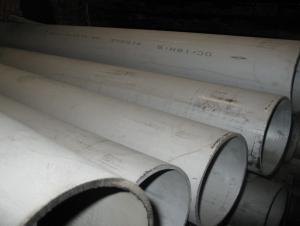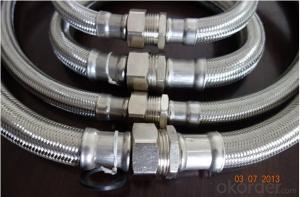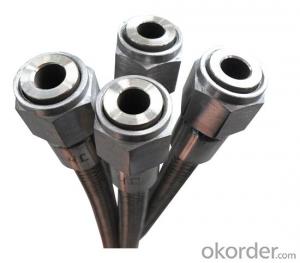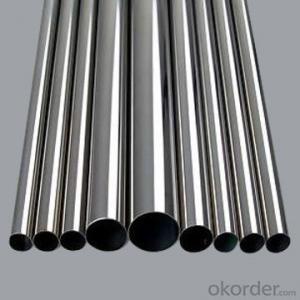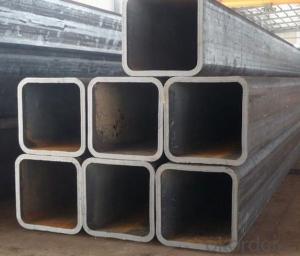STAINLESS STEEL PIPES AND FITTINGS OF 410 MATERAIL
- Loading Port:
- China Main Port
- Payment Terms:
- TT OR LC
- Min Order Qty:
- -
- Supply Capability:
- -
OKorder Service Pledge
OKorder Financial Service
You Might Also Like
Description:
Stainless Steel Pipe
Material:
304 321 316 310
Packing:
In bundle
MOQ:
5 TONS
Comparison of standardized steels
| EN-standard Steel no. k.h.s DIN | EN-standard Steel name | SAE grade | UNS |
|---|---|---|---|
| 1.4109 | X65CrMo14 | 440A | S44002 |
| 1.4112 | X90CrMoV18 | 440B | S44003 |
| 1.4125 | X105CrMo17 | 440C | S44004 |
| | | 440F | S44020 |
| 1.4016 | X6Cr17 | 430 | S43000 |
| 1.4408 | G-X 6 CrNiMo 18-10 | 316 | |
| 1.4512 | X6CrTi12 | 409 | S40900 |
| | | 410 | S41000 |
| 1.4310 | X10CrNi18-8 | 301 | S30100 |
| 1.4318 | X2CrNiN18-7 | 301LN | |
| 1.4307 | X2CrNi18-9 | 304L | S30403 |
| 1.4306 | X2CrNi19-11 | 304L | S30403 |
| 1.4311 | X2CrNiN18-10 | 304LN | S30453 |
| 1.4301 | X5CrNi18-10 | 304 | S30400 |
| 1.4948 | X6CrNi18-11 | 304H | S30409 |
| 1.4303 | X5CrNi18-12 | 305 | S30500 |
| | X5CrNi30-9 | 312 | |
| 1.4541 | X6CrNiTi18-10 | 321 | S32100 |
| 1.4878 | X12CrNiTi18-9 | 321H | S32109 |
| 1.4404 | X2CrNiMo17-12-2 | 316L | S31603 |
| 1.4401 | X5CrNiMo17-12-2 | 316 | S31600 |
| 1.4406 | X2CrNiMoN17-12-2 | 316LN | S31653 |
| 1.4432 | X2CrNiMo17-12-3 | 316L | S31603 |
| 1.4435 | X2CrNiMo18-14-3 | 316L | S31603 |
| 1.4436 | X3CrNiMo17-13-3 | 316 | S31600 |
| 1.4571 | X6CrNiMoTi17-12-2 | 316Ti | S31635 |
| 1.4429 | X2CrNiMoN17-13-3 | 316LN | S31653 |
| 1.4438 | X2CrNiMo18-15-4 | 317L | S31703 |
| 1.4362 | X2CrNi23-4 | 2304 | S32304 |
| 1.4462 | X2CrNiMoN22-5-3 | 2205 | S31803/S32205 |
| 1.4539 | X1NiCrMoCu25-20-5 | 904L | N08904 |
| 1.4529 | X1NiCrMoCuN25-20-7 | | N08926 |
| 1.4547 | X1CrNiMoCuN20-18-7 | 254SMO | S31254 |
Stainless steel’s resistance to corrosion and staining, low maintenance and familiar lustre make it an ideal material for many applications. There are over 150 grades of stainless steel, of which fifteen are most commonly used. The alloy is milled into coils, sheets, plates, bars, wire, and tubing to be used in cookware, cutlery, household hardware, surgical instruments, major appliances, industrial equipment (for example, in sugar refineries) and as an automotive and aerospace structural alloy and construction material in large buildings. Storage tanks and tankers used to transport orange juice and other food are often made of stainless steel, because of its corrosion resistance. This also influences its use in commercial kitchens and food processing plants, as it can be steam-cleaned and sterilized and does not need paint or other surface finishes.
Stainless steel is used for jewelry and watches with 316L being the type commonly used for such applications. It can be re-finished by any jeweler and will not oxidize or turn black.
Some firearms incorporate stainless steel components as an alternative to blued or parkerized steel. Some handgun models, such as the Smith & Wesson Model 60 and the Colt M1911 pistol, can be made entirely from stainless steel. This gives a high-luster finish similar in appearance to nickel plating. Unlike plating, the finish is not subject to flaking, peeling, wear-off from rubbing (as when repeatedly removed from a holster), or rust when scratched.
- Q: Are stainless steel pipes suitable for air conditioning systems?
- Yes, stainless steel pipes are suitable for air conditioning systems. Stainless steel is highly resistant to corrosion, which makes it an ideal material for air conditioning systems where moisture and condensation can occur. It is also strong, durable, and can withstand high temperatures, making it suitable for the harsh conditions typically found in air conditioning systems. Additionally, stainless steel pipes have a smooth inner surface, which helps to minimize friction and improve the flow of air. Overall, stainless steel pipes provide excellent performance and reliability in air conditioning systems.
- Q: Are stainless steel pipes resistant to scaling and pitting?
- Yes, stainless steel pipes are highly resistant to scaling and pitting due to their inherent corrosion-resistant properties.
- Q: Can stainless steel pipes be used for sewage applications?
- Yes, stainless steel pipes can be used for sewage applications. Stainless steel is a highly durable and corrosion-resistant material, making it an ideal choice for handling sewage and wastewater. It is resistant to chemicals and other harsh substances commonly found in sewage systems, ensuring long-lasting performance and minimal maintenance. Additionally, stainless steel pipes have smooth interior surfaces, which reduce the likelihood of clogs and blockages caused by debris or build-up. Overall, stainless steel pipes are a reliable and hygienic option for sewage applications.
- Q: What is stainless steel decorative tube? What uses does it have?
- For the steel to withstand the pressure to the hydraulic test to test its ability and quality, leakage, soaked or expansion for qualified does not occur at the prescribed pressure, some steel according to the requirement of standard or edge test, flaring test and flattening test.Seamless stainless steel tube, also called stainless steel seamless pipe, is made of ingot or solid tube blank by piercing, and then made by hot rolling, cold rolling or cold casting. Specifications for seamless steel tubes are expressed in millimeters of outer diameter * wall thickness.
- Q: Can stainless steel pipes be insulated with polyacrylonitrile?
- Indeed, polyacrylonitrile (PAN) can be employed to insulate stainless steel pipes. PAN, a highly adaptable and widely utilized polymer, boasts exceptional thermal insulation capabilities. Thanks to its low thermal conductivity and resistance to heat transfer, PAN is frequently utilized as a foam or fiber insulation material. Applying PAN insulation to stainless steel pipes is a straightforward process that aids in minimizing heat loss or gain, enhancing energy efficiency, and averting condensation. Furthermore, it affords protection against corrosion and mechanical harm.
- Q: What is the difference between 304H and 304L stainless steel pipes?
- The carbon content is the main distinction between 304H and 304L stainless steel pipes. 304H pipes contain a higher carbon content, typically ranging from 0.04-0.10%, making them ideal for high-temperature uses. This increased carbon content enhances their strength and resistance to sensitization, which is the creation of chromium carbides at grain boundaries, resulting in reduced corrosion resistance. On the flip side, 304L stainless steel pipes possess a lower carbon content, usually around 0.03%, making them more appropriate for welding purposes. The reduced carbon content helps minimize the formation of chromium carbides, thereby lowering the risk of sensitization during welding. As a result, corrosion resistance is improved, and weldability is enhanced. To summarize, albeit both 304H and 304L stainless steel pipes are variations of the 304 grade, their distinction lies in their carbon content. 304H pipes are favored for high-temperature applications due to their higher carbon content and improved high-temperature strength, while 304L pipes are better suited for welding applications due to their lower carbon content and enhanced weldability.
- Q: How do you prevent condensation in stainless steel pipes?
- To prevent condensation in stainless steel pipes, there are several measures you can take: 1. Insulation: Apply insulation materials, such as foam or fiberglass, around the pipes. This will help maintain the temperature inside the pipe, preventing the outer surface from becoming cold and reducing the likelihood of condensation. 2. Vapor barriers: Install vapor barriers around the pipes to prevent moisture from reaching the pipe surface and causing condensation. These barriers can be made of materials like plastic or aluminum foil and should be properly sealed to ensure their effectiveness. 3. Increase pipe temperature: If possible, increase the temperature of the fluid or gas flowing through the pipes. This can be achieved by adjusting the temperature of the heat source or utilizing heat tracing systems that provide a constant heat supply to the pipe. 4. Proper ventilation: Ensure there is adequate airflow around the pipes, especially in areas where condensation is more likely to occur. This helps to dissipate any moisture that may accumulate and reduce the chances of condensation. 5. Reduce humidity: In areas with high humidity, consider implementing dehumidification methods, such as using dehumidifiers or installing moisture-absorbing materials, to lower the overall moisture content in the air. This can help minimize the potential for condensation. By implementing these preventive measures, you can significantly reduce the risk of condensation in stainless steel pipes, thereby protecting them from potential corrosion and maintaining their overall performance and longevity.
- Q: What is the difference between sanitary and industrial stainless steel pipes?
- Sanitary and industrial stainless steel pipes differ primarily in their intended use and the level of cleanliness required. Sanitary stainless steel pipes are specifically designed for applications in the food and beverage industry, pharmaceutical industry, and other sanitary environments where cleanliness and hygiene are of utmost importance. These pipes are manufactured with a higher level of surface finish, typically a smooth and polished surface, to prevent bacteria growth and ensure easy cleaning. The inner surface of sanitary pipes is often electropolished to further enhance its smoothness and resistance to corrosion. Additionally, sanitary pipes are often equipped with tri-clamp fittings or other sanitary connections to facilitate easy disassembly for cleaning purposes. On the other hand, industrial stainless steel pipes are used in a wide range of applications, including manufacturing, oil and gas, chemical processing, and construction. These pipes are typically designed to withstand high pressures, extreme temperatures, and harsh environments. Industrial pipes may have a rougher surface finish and may not require the same level of cleanliness as sanitary pipes. They are often welded or threaded together for assembly and are built to withstand heavy-duty usage. In summary, the main differences between sanitary and industrial stainless steel pipes lie in their intended use, surface finish, and level of cleanliness required. Sanitary pipes prioritize hygiene and ease of cleaning, making them suitable for food and pharmaceutical applications. Industrial pipes, on the other hand, focus on durability and strength to withstand demanding industrial environments.
- Q: What is the difference between schedule 10 and schedule 160 stainless steel pipes?
- The main difference between schedule 10 and schedule 160 stainless steel pipes is their thickness and pressure rating. Schedule 10 pipes have a thinner wall thickness and a lower pressure rating compared to schedule 160 pipes, which have a thicker wall thickness and a higher pressure rating. Additionally, schedule 160 pipes are typically used for high-pressure applications, while schedule 10 pipes are suitable for low to medium-pressure applications.
- Q: Are stainless steel pipes suitable for nuclear power plants?
- Yes, stainless steel pipes are suitable for nuclear power plants. Stainless steel is widely used in nuclear power plants due to its excellent corrosion resistance properties, high strength, and ability to withstand high temperatures and pressures. These pipes are used for various purposes in a nuclear power plant, including carrying coolant, steam, and other fluids. Stainless steel pipes are highly resistant to corrosion, which is crucial in preventing leakages and maintaining the integrity of the system. Additionally, stainless steel is also resistant to radiation damage, making it a suitable material for nuclear power plant applications.
Send your message to us
STAINLESS STEEL PIPES AND FITTINGS OF 410 MATERAIL
- Loading Port:
- China Main Port
- Payment Terms:
- TT OR LC
- Min Order Qty:
- -
- Supply Capability:
- -
OKorder Service Pledge
OKorder Financial Service
Similar products
Hot products
Hot Searches
Related keywords








